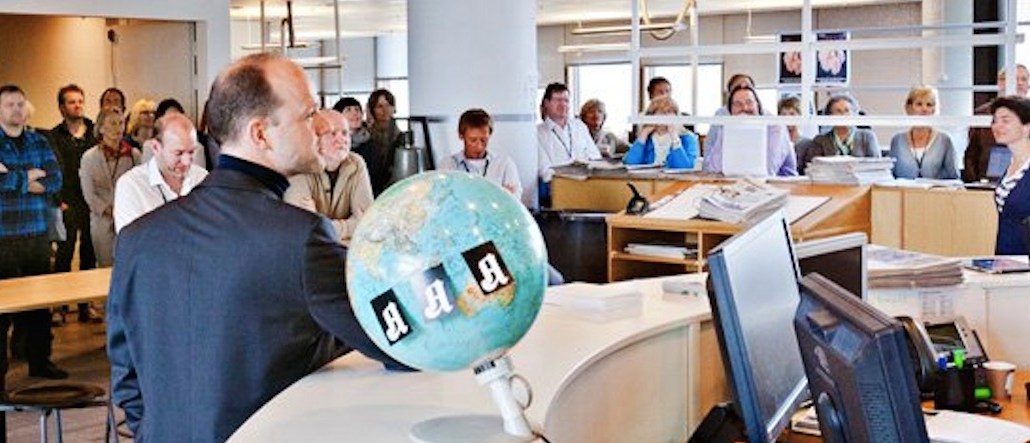Save 50% on a 3-month Digiday+ membership. Ends Dec 12.
How Norwegian daily Aftenposten doubled digital subscribers in a year

Norwegian newspaper Aftenposten is the latest publisher to see the value in loyal subscribers over indiscriminate reach: Over the past year alone, it doubled paying readers from 32,000 to 70,000.
“There’s been a shift in mentality from views, reach and page impressions to how many subscribers we have and how we can make them happy,” Tor Jacobsen, chief commercial officer at parent publisher Schibsted, told Digiday. “The culture change we have had has been very important: Daily editorial meetings used to be about which articles drew the most traffic, now it’s about which articles drew the most subscribers.”
Aftenposten introduced a metered paywall in 2013 so that non-subscribers could read six articles a week. The problem was that news content is available for free in numerous places, including Facebook. To get people to pay, it needs to add value. In 2015, it introduced more premium content for subscribers, while keeping the metered paywall. Now about 20 percent of Aftenposten’s 150 daily articles, more in-depth pieces — like this investigation about a safehouse for victims of domestic abuse — are available to subscribers.
Typically, it finds emotional stories on important or engaging themes drive conversions, like the domestic abuse article, or pieces that give the user insight on themes of personal interest or personal gain, like this piece on seemingly healthy foods that aren’t good for you.
“It’s important that paid content is core to our product for readers,” said Jacobsen. “It’s core for our editorial department and for our commercial department.”
It seems to be paying off. Now 65 percent of Aftenposten’s print and digital revenue comes from subscribers, and 35 percent is from advertising. A monthly digital-only subscription to the Norwegian conservative publisher is 199 kr ($24). It also offers print and digital subscriptions for a higher prince, but these aren’t included in the 70,000 figure. Total circulation, including print, is approximately 230,000. Five years ago, 60 percent of revenue came from advertising.
The publisher is also being more data driven in how it acquires new subscribers. Aftenposten has driven roughly 20 percent of digital-only subscriptions through Facebook, serving ads featuring specific articles targeted to audience segments by gender, age and location. Articles that convert well from Facebook tend to be those that give insight on an individual level, “those about macro-dynamics (politics, foreign news and economics) in society rarely work, but insight on emotions often does,” he said.
“We have been testing different messages and communication,” Jacobsen said. “For Aftenposten we’re making it more like a membership. Both subscribers and non-subscribers should be able to see pretty clearly what they are missing if they don’t subscribe, and we are including and promoting more of our content for subscribers only. We are also looking to add more content categories for subscribers.”
Gaining more subscribers is one thing, making sure you keep them is the challenge for 2017. To this end, the publisher is experimenting with newsletters. So far, it only has one regular daily email newsletter which runs a mix of free and paid-for articles, although it has run several pop-up versions during events like the U.S. election. The plan is to make this more personalized for subscribers. Jacobsen couldn’t share the number of subscribers the newsletter has but did say the open rate is 35 percent.
It’s applying this same philosophy to its homepage: For subscribers, the first three stories would be editorially driven and the same for everyone, a level of editorial control that can help avoid the Facebook echo-chamber, where readers can get sucked into only seeing content they are already interested in. The following articles will be algorithmically chosen based on personal preferences. It’s testing this with 20 percent of subscribers to the homepage. Jacobsen didn’t say when this would be implemented, just that the spring will be an important time for the publisher.
“I think there’s a need in the market for a digital edition — reading the digital pdf is still popular — people have not cracked the code of digital editions yet, but a personalised daily newsletter is one way we are testing it.”
Another bonus for the publisher is that its digital-only readers skew younger than print too: First-time digital subscribers to Aftenposten average 41 years old versus an average age of 65 for a traditional print subscriber. Partly Jacobsen puts this down to companies like Netflix and Spotify making the case that people are willing to pay for content.
Images: courtesy of Aftenposten via Facebook.
More in Media

As big brands flood the podcast ad space, startups are refining strategies to stand out
While a influx of big advertisers is good news for podcast companies, it also makes it more challenging for small- to mid-sized brands to stand out in the space.

Meta enters AI licensing fray, striking deals with People Inc., USA Today Co. and more
The platform has secured seven multi-year deals with publishers including CNN, Fox News, People Inc., USA Today Co to incorporate their content into its large language model (LLM) Llama.

European publishers say the Digital Omnibus ‘cookie fix’ leaves them worse off
The European Union’s attempt at a legislative spring clean for Europe’s web of data privacy rules, has landed flat with publishers.








